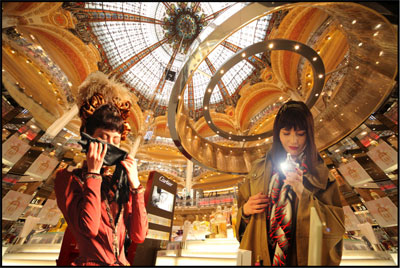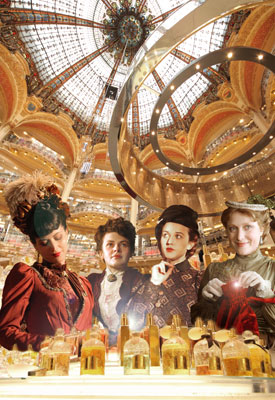Sylvia Sagona Seduction in the City Interview

Sylvia Sagona Seduction in the City Interview
Seduction in the City: The Birth of Shopping is the fascinating two part series that tells the story of the department store - how it became the greatest invention to emerge from the industrial revolution and ultimately changed the role of women in society forever.
This elegant documentary series reveals the foresight of internationally renowned store entrepreneurs such as France's Aristide Boucicaut, Britain's Harry Selfridge, New York's Rowland Macy and Australia's own Sidney Myer, who invented such revolutionary concepts that now form the basis of everyday shopping conveniences. These include easy credit, returns policies, window displays, changing rooms and ladies' toilets. The foresight of these men and the department stores they created offered women the first chance to have a career outside of the home.
Seduction in the City brings to life the ambitious and magical world of the 19th century department store with rich reconstructions of key characters, rare archival footage of Myer's opening in Victoria, sophisticated animation and illuminating interviews together with quirky advertisements, extraordinary diary excerpts and letters and posters of the age. It tells the untold social history of the phenomenon of shopping that took hold of the world and transformed the lives of women, national economies and saw the birth of consumer culture. The inspiration for the documentary came from the research and work of Melbourne-based academic, Sylvia Sagona, whose playful take on history is refreshingly humorous.
Episode One- "A Genius Idea"
Wednesday July 27, 8.30pm
The first episode of Seduction in the City introduces viewers to the world's first department store created by the visionary 19th century French entrepreneur, Aristide Boucicaut.
Boucicaut's store, Le Bon Marché, situated on the left bank of Paris and engineered by the famous Gustave Eiffel, is a huge success and his magnificent "cathedral of commerce" is very quickly copied all over the world. Stores like Selfridges in London, Myers in Melbourne and Macys in New York develop the idea further, craftily inventing more enticing ideas to lure in customers and sell industrial goods in huge numbers.
Consumer culture is born.
This episode also establishes four archetypal, female characters, Mrs Debt, Mrs Homemaker, Lady Kleptomania and Miss Assist. These dramatic characters illustrate the changing presence of women's place in society. This episode focuses on Miss Assist's ascent from provincial shop girl to department manager eventually running her own store, in contrast with Lady Kleptomania's immersion in the darker side of shopping - stealing for pleasure.
Episode Two- "A Modern Game"
Wednesday August 3, 8.30pm
The second episode reveals the canny secrets of the retail game in the early part of the 20th century, examining the tactics of the world's greatest retailers.
Philadelphia merchant, John Wanamaker, exploits religion by being the first vendor to create sales on Christian festivals: Christmas and Easter. Wanamaker even invents Mother's Day to encourage shoppers to spend more.
Meanwhile, penniless Russian immigrant to Australia, Sidney Myer, suppresses his Jewish faith by trading on the Sabbath to fit in with the Anglo majority. This controversial decision works in his favour as his business grows from pushcart to major city institution in less than a decade. Myer also helps shatter class barriers by the introduction of a department store staple - the bargain basement.
Over in England, the showman, Harry Gordon Selfridge in London dazzles his store 'guests' with new inventions including escalators, electric windows and telephones. Also in this episode the role of Mrs Debt is explored as she falls into every trap set by the department store. Her radical solution to paying her increasing bills is prostitution. In contrast, Mrs Homemaker outwits the stores triumphantly exploiting store freebies. Seduction in the City uncovers a whole host of remarkable facts – some funny, some controversial and some downright strange! Here are ten that caught our eye:
Girls Just Want To Have Fun: For the women of 1852, the department store was a symbol of independence: here was a place outside of the house where you could go by yourself – without your maid or your husband.
Sisters Are Doing It For Themselves: in the 1900's department stores were worried about their image as drivers of social depravity, so they hired more shopgirls- and inadvertently created a liberated female workforce.
Suffragette City: The women in the suffragette movement used the department stores' tea rooms as gathering points for their meetings.
Material Girl: -Kleptomania' entered the medical textbooks at the same time as department stores appeared.
Moving On Up: After the installation of the world's first escalators, nurses with smelling salts were present in case customers became faint upon alighting.
Uptown Girl: The department store was one of the main drivers for class erosion – with everyone shopping in the same place there was no longer a visual indicator of who was upper and who was lower class.
Man, I Feel Like a Woman: In a time when a woman's morality was valued, department stores were seen as highly proactive, with men and women freely mixing together.
Money Money Money: In 1909, Selfridges spent an unheard of amount on advertising – the equivalent of £2.5million – to herald the store's grant opening.
She's Got The Look: Le Bon Marche's founder, Aristide Boucicaut, invented the modern idea of visual merchandising, using vivid colours and touchable textures to dazzle and enthral customers.
Seduction in the City The Birth of Shopping premieres Wednesday 27 July at 8.30pm on SBS.
Interview with Sylvia Sagona
 Question: What inspired you to create the documentary Seduction in the City?
Question: What inspired you to create the documentary Seduction in the City?
Shopping is connected to desire and the novel is about the development of consumerism and the idea of buying the 'dream' that always resides in front of you and the fact that you buy more to correspond to that dream. At this time in Paris you were getting the new architecture with the industry revolution and the buildings in Paris were being constructed from iron and glass, similar to modern Cathedrals; Émile François Zola beautifully describes these buildings. This novel was written in a time were there was no other media, the novel was an extraordinarily experience of hitting the senses and you were enticed to the extraordinary spaces of stained glass were you left your problems and common sense at the door to be lost in a maze of counters and goods.
What Émile François Zola documented is the rise of the phenomenon that I find absolutely fascinating and I tried to translate what I lecture at the University with a director into a visual documentary. I tried to translate ideas into a visual and I found it quite challenging.
Question: Can you talk about your lectures and what a typical day is like for you?
Sylvia Sagona: I teach at the University, I deal with a huge number of lectures at the Natural Gallery related to the 19th century, which is my specialty, and I have my own cultural travel company. Shopping as a research topic has risen from an academic interest.
There is irony in the fact that in the 19th century middle-class women were kept at home and with the development of department stores they had to be brought out from the home to spaces of the city as clients; women were redefined as people who were quite valuable to society because they were the people who were doing the spending. This is the same now; a lot of the shoppers are woman.
Question: SBS has described your playful take on history as "refreshingly humorous" what do you describe it as?
Sylvia Sagona: It wasn't originally supposed to be a playful take; I think we were trying to make Seduction in the City accessible because there are a lot of ideas behind the phenomenon of shopping. I started the production with a serious idea that the phenomenon of shopping had an effect on the way woman perceived themselves in the 19th century; my lectures are usually on the sociological forces and I look at it through literature and art. I was told I was being too serious and that the short television piece may not come across particularly well so I tried to lighten up what could have possibly been seen as large lumps of history. My aim was to make people understand the importance but at the same time making it widely accessible.
Question: Overall, what is your favourite department store?
Sylvia Sagona: Galeries Lafayette because, I think, it still gives you that 19th century experience. When you walk into Galeries Lafayette you walk into an immense space and it's like a cathedral in the sense there is a central dome which is all stained glass that goes right up to the second ceiling and all around it is 19th century theatre boxes, all the way round, it is almost as if you're at the theatre. You can go up and stand in one of the boxes on each level and originally Galeries Lafayette would have had a massive staircase that went right up, even now you go in there and it's an amazing experience that draws you up into the lights.
I wonder what it must have been like for people in the 19th century, who weren't used to having their senses bombarded by television and radio, when they suddenly walk into these magical spaces.
For the first time Galeries Lafayette put merchandise out and for the first time you could actually look at it. Secondly you had free entry; up until then you'd walk in and be grabbed, there was no browsing. Galeries Lafayette also had fixed prices; you used to have to negotiate prices. Suddenly shopping went from being a chore and an intimidating experience to something you can do with a friend, all day. The department stores in the 19th century had reading rooms, art galleries, incredible displays and mirrors everywhere - it was a dazzling experience quality of goods.
Department stores today have lost that magic because the rest of our society is doing what the department stores used to do.
Sylvia Sagona: As people get busier, when they just need nuts and bolt items I would imagine they would choose online shopping because let's face it, it is probably cheaper and in many ways there is more choice. I think that people still use shopping as leisure; even those who are online shoppers will occasionally go into the browsing experience that you get when physically shopping. I know when I shop not necessarily for clothes but for art or books my heart beat slows down and you're in a zone - I think that's something that you cannot get online. Online is a practical transaction which is different from the experience of a store.
I think Myer are trying to recapture the affect as they have removed some floors so you can see the sky, with the light coming in - it is almost returning to the original 19th century ideas.
Interview by Brooke Hunter
MORE



